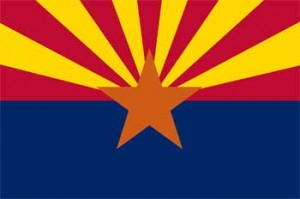Arizona Emergency Vehicle Light State Statutes
 Under Arizona state statute 28-101, drivers are directed as to what lights they should look out for from emergency vehicles, as well as what permits are needed to have warning lights on their vehicles. Arizona has very strict laws on who can have what lights on their vehicles. In fact statute 28-947 has the guidelines and punishments for what happens when a driver has any type of lamp or light device that has blue and red lights.
Under Arizona state statute 28-101, drivers are directed as to what lights they should look out for from emergency vehicles, as well as what permits are needed to have warning lights on their vehicles. Arizona has very strict laws on who can have what lights on their vehicles. In fact statute 28-947 has the guidelines and punishments for what happens when a driver has any type of lamp or light device that has blue and red lights.
First responders have to use different emergency vehicle lights to let people know to get out of the way and move to the side in emergency situations. These lights grab people's attention and make them away of what hazard based on the light status. Police, fire trucks, ambulances, and other vehicles all display certain colors of lights that they are allowed to use. There may be other vehicles that use different statuses under a permit, such as a utility vehicle or school bus.
The following lights are described under the main state statute and should give you a better idea of what emergency vehicles use each light status for.
Police Lights
There are different sections within the statute that govern city police, Sheriff lights, and state trooper lights. Each vehicle has the same color police lights, but the markings on their vehicles are different and they have additional warning lights as well.
City Police Lights
These vehicles are meant to have a standard red light on top of the vehicle that is forward-facing, while a blue light can flash or remain constant when turned on. The blue light can be in other areas of the car, but the red light must be on top of the vehicle.
Sheriff Lights
These are very similar to city police lights, but Sheriff vehicles may have more blue lights that flash in addition to red lights. The red light must be forward facing and on top of the vehicle, just like with city police.
State Trooper Lights
These vehicles mostly use blue lights, but they may have a red light as well. If the vehicle does have a red light, it must be forward facing and should be in the front of the vehicle. Some vehicles have blue lights in the dash and back window area that flash when turned on.
Fire Truck Lights
Most people don't realize that fire trucks get called out to accidents and roadside events on a regular basis to prevent fires and provide assistance. Just like ambulances and police cars, fire trucks have different lights and sirens to denote that they are responding to an emergency. Fire trucks in Arizona have multiple flashing lights, but they must have forward-facing red lights that flash when there is an emergency. They may also have white fire truck lights on the side that blink rapidly.
Volunteer Fire Fighter Lights
If a volunteer is responding to a scene, they may be permitted to use yellow or white warning lights, but they are not permitted to use official red or blue lighting. These are for official state emergency vehicles only.
Ambulance Lights
If you have an emergency response vehicle, such as ambulance, you must have a red light that is forward facing on the top of your vehicle. There may be other lights on the ambulance, but the main color must be red. However, many ambulances very between red and red/white warning lights. These are both permitted under statute 28-624.
Tow Trucks Lights
Since tow trucks are not officially emergency vehicles, they have different light status requirements. Under statue 28-624, no other vehicle is allowed to used red or red and blue lights except for police, fire trucks, and ambulances. Tow trucks must only use white or yellow warning lights when they are in the act of towing on the road for roadside assistance. However, they are not to use their lights in any way that symbolizes they are a police officer or an emergency responder.
Construction Vehicle Lights
Other sections of the statute deal with roadside issues and construction. These vehicles must have certain lighting to tell drivers that they are going to be moving slowly or that they are carrying an oversized load. Under statue 28-947, you will find that these vehicles can have yellow or amber lights, as well as white warning lights. These lights must not be used to try and intimidate other drivers as they are not police or emergency responder lights.
Utility vehicle Lights
When power trucks are responding to a disaster, such as a power outage, you may see yellow or amber lights as well as white lights. According to statute 28-947, these are emergency lights that denote dangerous situations and emergency use, typically when a vehicle needs to park in traffic in order for the technician to fix the issue. If there are live wires, you may see that the car is blocking traffic to prevent a hazardous situation.
Pilot Vehicle Light
 Pilot cars denote a warning that a vehicle is oversized. These vehicles can also have special warning lights that denote other drivers to take notice of the extra wide load and that they may need to take precaution as they pass by. These vehicles have white and amber lighting according to statute 28-947. These vehicles are not emergency responders, so they may not use the lights to intimidate other drivers. They are only to be used when they are escorting an oversized load vehicle.
Pilot cars denote a warning that a vehicle is oversized. These vehicles can also have special warning lights that denote other drivers to take notice of the extra wide load and that they may need to take precaution as they pass by. These vehicles have white and amber lighting according to statute 28-947. These vehicles are not emergency responders, so they may not use the lights to intimidate other drivers. They are only to be used when they are escorting an oversized load vehicle.
Security Vehicle Lights
You may have seen security guards at a building driving in a car with different lights on top or you may see a mall security guard that patrols the parking lot with lights on the top of the car. These lights are designated under 28-947 to have yellow, amber, or white warning lights. These vehicles must have permits to have these strobe lights, as they may appear to be emergency responders or police, but they are actually employed by the private property upon which they patrol.
Snow Plow Lights
In areas where it gets colder with snow, you may see snow plots under statute 28-947 that are permitted to have amber and yellow lighting. This is important as many times they are moving slowly and working n the roads to make them clear for other drivers.
School Bus Lights
School buses also have designated lights under 28-947 in Arizona. The statute provides restrictions on the types of lights that the school bus can display, but they are allowed to have yellow and white flashing lights, particularly when they are dropping kids off and need to have the "stop" sign activated. However, school bus lights blink as they drive as well, and they blink when the vehicle stops to drop off students.
Penalties for Driving with Emergency Lights
If you drive with emergency lights or any lighting device that resembles a police car, you will be in big trouble in Arizona. Impersonating an official emergency vehicle can cost you big in fines and jail time. Under Arizona DOT policy, there is approval criteria for certain color lights, but red and blue lights will always be under a different designation than warning lights or amber lights. While it is a misdemeanor to impersonate a police office, it could carry a heavier fine and punishment if you have red and blue lights that flash, and if you impersonate a police car by pulling people over.
For more information about what lights may be available to you, we suggest calling your State Highway Patrol office at: 602-542-0362
*Please note that these numbers are what we are currently able to find and the numbers may have changed since this listing.
Disclaimer: The emergency vehicle light state statute guide was created by Extreme Tactical Dynamics as a guide and reference. We make no claim to the accuracy or validity of this guide. This guide was written to the best of our knowledge and has been provided to our customers as a courtesy ONLY! The information in this guide is our interpretation of the law as we have read it. We cannot be held responsible for any errors as this is only our interpretation of the law and the laws are constantly changing. We cannot be held liable or responsible for any errors and recommend that our customers refer to their local authorities to confirm the particular statue that governs their use of emergency vehicle lights.
 Facebook
Twitter
Google+
Instagram
YouTube
Facebook
Twitter
Google+
Instagram
YouTube


